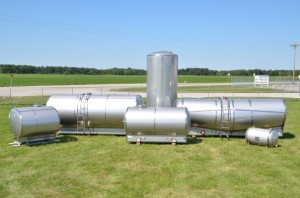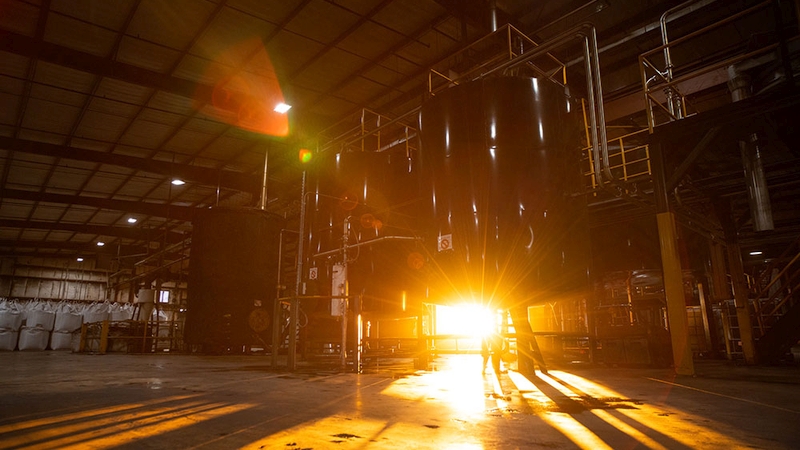Tanks Still Shining
Though worries about the impact of the drought are the topic of many conversations in ag, tank makers we talked with say they are not overly concerned. First off, many growers have crop insurance that will cover their losses. And, in fact, some farmers are seeing “phenomenal successes” with yields, reports Sid Lockhart, marketing manager with Meridian Manufacturing, a firm that does business across North America.
In fact, sales are strong for all sizes of tanks, from capacities of 2,000 gallons on up to 2 million — and customers include large-scale retailers and growers. Both fiberglass and steel units are moving well.
“A few people have backed off buying tanks, but overall business has been very good,” says Ron Lager, sales manager with Precision Tank & Equipment (PT&E). While low corn yields will leave some phosphate and potash in fields, nitrogen will be needed in various forms including liquids, he says — and his company’s tanks will be needed.
PT&E has again seen particular growth in fiberglass tank sales, to the point where the firm had to add more machinery to handle increased fiberglass production at its recently expanded plant. The reason, Lager believes, is due to the longevity and low maintenance of fiberglass tanks.
Dennis Neal, president of Enviropac, Inc. says larger national customers are continuing with expansion plans — and buying his company’s fiberglass tanks — in spite of drought and economic conditions.
At Mid-State Tank, Tom Munro reports that sales of nurse tanks at the company also grew in 2012, but he believes it is too early to tell if this market will be affected by drought issues.
“Demand for and use of liquid tanks is definitely on the increase, whether it’s large agribusiness or on-farm,” says Lockhart. Meridian builds single-walled, multi-purpose hopper bins for liquid fertilizer. Actually, the coated, smooth-walled stainless steel design allows use for liquid fertilizer, grain, granular fertilize, or water, depending on the time of year.
Large-Scale Challenges
Heartland Tank LLC makes large-scale, field-erected tanks that range from 300,000 to four million gallons, and Chris Brooks, U.S. sales manager, says his staff is still “real busy.” He has eight crews doing construction exclusively for the fertilizer industry — and “we’re quoting March or April before we can start another tank,” he reports.
Brooks says a big part of each project is getting a foundation laid for the huge tanks, and that can take months. The foundations need to be carefully designed and require a registered engineer from a retailer’s state, one that knows local soils. He is telling customers they need to do six to nine months of pre-planning.
Brooks also manages sales for Heartland Tank Services, which provides inspections of tank containment systems. Many states now require an API 653 inspection by a certified inspector after so many years, with the frequency varying by state. Brooks’ crew follows The Fertilizer Institute recommended guidelines of inspections every five years. His two two-man teams will check out anywhere from 130 to 170 fertilizer tanks per year.
Neal reports that as retailers start to do API 653 inspections for the first time on big tanks with Enviro-Coat protector inside, “they’re telling us that the tanks look absolutely fantastic. It’s confirmation that the product is doing what we all anticipated it to do.”
Heartland Tank Services also sells and repairs PVC flexible membrane liners, also called bladders, which become a tank’s primary containment. The systems include leak monitoring behind and underneath the bladder.
Butch Kirk, president and CEO of International Tank Service, Inc. (ITS) says business has been quieter on the fertilizer front for his firm — which also builds large tanks for asphalt, crude oil, gasoline, jet fuel, and potable water. “It’s the same tank, it wears a lot of hats,” he says. “You just have to do that these days.”
Kirk believes this is a great time for fertilizer retailers to buy, with U.S. steel prices level or trending slightly downward — especially considering half the price of a tank build is in steel costs.
Containment Update
Again this year, Hunter Agri-Sales’ Plia-Pad unit has seen the most sales, especially as more and more states become concerned about run-off at airports, says Ken Hunter, president.
He also noted that the Plia-Pad now comes in a new synthetic material that is resistant to most chemicals and solvents, making it ideal for secondary containment. The material has been used in Plia-Dikes to line concrete chemical dikes that are cracking — and it contains fertilizer and petroleum products as well.
Meridian will soon be releasing a “pretty exciting” semi-stationary dike option, in great part in answer to customer requests for the containment.
Lockhart says double-walled tanks are a good containment solution. Meridian has been promoting this option for on-site fuel storage — versus single-walled tanks. Sales of the units have doubled every year as producers see the need for on-farm fuel, Lockhart explains.
The design includes containment within the unit and allows buyers flexibility and the choice to move a tank as a facility expands. In liquid fertilizer, the double-walled option for smaller tanks may still be considered a bit too costly.
Concerns For The Future
Because of outstanding demand for their products, tank manufacturers have found one of the biggest challenges they face has been the lead time they now need to build. And getting the staff to do the building is a real challenge. Lockhart says his firm struggles to find both the quantity and quality of labor needed to keep up with demand. Meridian has done “quite a bit” of expansion at its facilities the last few years, to create enough production capacity.
A number of tank experts we talked with emphasized the need to plan ahead — a lot — when purchasing a tank. “Even if a customer wants to expand next year, they need to start the discussion and planning now,” says Lockhart.
Neal admits that lead times at his company are getting long because sales are so good. It sounds like a good thing to a point, he says, but some possible buyers are deciding to wait to order.






